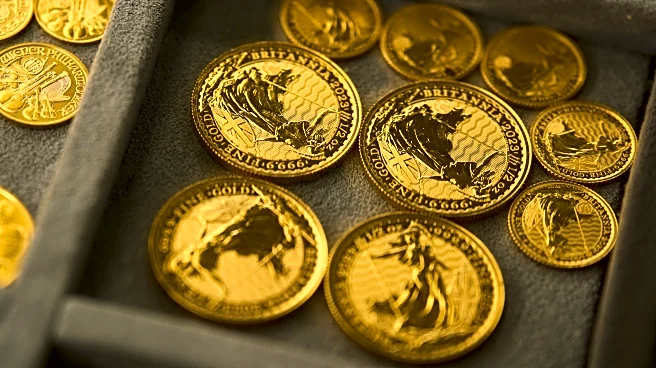What's Happening?
Gold futures have reached a historic high, surpassing $4,000 per troy ounce for the first time. This surge is attributed to investors seeking safe havens during the ongoing U.S. government shutdown. The price of gold had previously closed at $3,960.60 per troy ounce. The shutdown has exacerbated economic uncertainties, leading to increased demand for gold and other precious metals like silver, which has also seen significant gains. The rise in gold prices is further fueled by President Trump's trade policies, which have introduced tariffs causing global economic uncertainty. Additionally, the Federal Reserve's recent interest rate cuts have made gold a more attractive investment compared to interest-bearing assets.
Why It's Important?
The increase in gold prices reflects broader economic anxieties, particularly those stemming from the U.S. government shutdown and trade tensions. As investors turn to gold as a secure investment, it highlights the instability in other sectors, including the job market and consumer confidence. The shutdown has delayed key economic data and affected federal employees, contributing to the uncertainty. The rise in gold prices also impacts industries reliant on precious metals, such as jewelry, where increased costs may lead to higher consumer prices. This situation underscores the interconnectedness of political decisions and economic outcomes, affecting both domestic and global markets.
What's Next?
The ongoing government shutdown and potential further interest rate cuts by the Federal Reserve could continue to influence gold prices. Investors may remain cautious, seeking to diversify their portfolios with gold as a hedge against inflation and economic instability. The shutdown's resolution could alter market dynamics, potentially stabilizing other investment avenues. Additionally, the environmental impact of increased gold demand, particularly through illegal mining practices involving mercury, may prompt regulatory scrutiny and efforts to mitigate health risks associated with mercury exposure.
Beyond the Headlines
The surge in gold prices has broader implications, including environmental and health concerns. The demand for mercury in illegal gold mining poses significant risks, leading to pollution and health hazards in affected regions. This highlights the ethical and environmental dimensions of the gold industry, prompting discussions on sustainable mining practices and regulatory measures to protect vulnerable communities.












